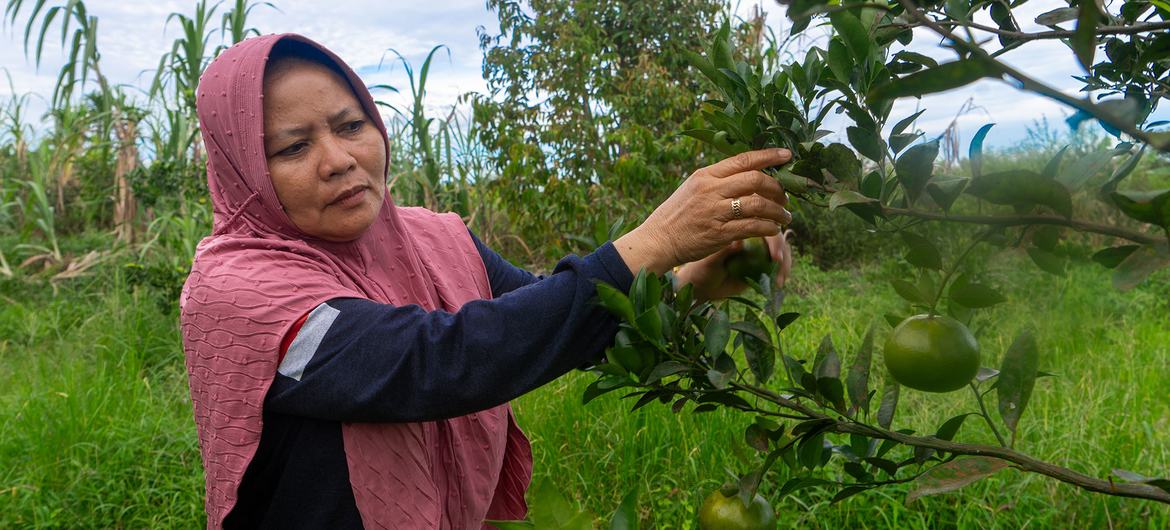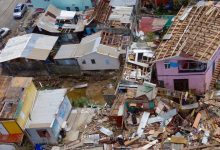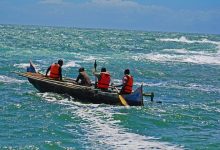The Scoop on How Indonesia’s Nailing It with Wildfire Control
When volunteer firefighter Marlizar noticed smoke billowing over a quarter-hectare of peatland while on a routine patrol in 2019, he dispatched his colleague to their base in Riau province’s Teluk Maranti village, seven kilometres away, and faced the fire alone.
As Marlizar’s colleague sped off to retrieve a clunky hose unit, the 42-year-old attempted to beat back the flames with a tree branch while alerting the disaster management agency. Experience had taught him how to stay safe from smoke inhalation. “The only thing on my mind was what could I do to stop the fire from spreading, he says.”
Despite Marlizar’s valiant efforts, the flames had engulfed five hectares within an hour. In the two more hours it took for the hose unit to arrive—transported by speed boat, then hefted on several fire-fighters’ shoulders—the peatlands were ablaze as far as he could see.
In Teluk Meranti, in the following days and weeks, schools, airports, and government offices were forced to close as smoke thickened the air.
Losses in the billions
Indonesia’s 2019 wildfires burned 3.1 million hectares, an area bigger than Belgium, blanketed six other countries in smoky haze, released almost 604 million tonnes of CO2 and caused some 900,000 people to report respiratory illnesses. The fires also inflicted $5.2 billion in losses in Indonesia, according to the World Bank, adding to the US$16 billion caused by even larger fires in 2015.
According to the UN Environment Programme (UNEP) worse is still to come; the UN body expects a 14 per cent increase in forest fires globally by 2030 due to a mixture of climate change and changing land use.
But in Indonesia, a UNEP-led integrated fire management pilot project, financed by USAID, has, since 2021, helped build greater fire resistance in three of the country’s most fire-prone districts.
It draws inspiration from a “cluster-based” approach towards land management practiced in South Africa—bringing together the knowhow of community fire-fighting brigades like Marlizar’s, the reach of government agencies, and the resources of some of Indonesia’s largest private companies.
The project’s aim of enhancing coordination between community, government, and private land users could hold lessons for fire-prone countries around the world.
“Forest fires inflict massive humanitarian, environmental and economic costs, especially when they occur on carbon-rich peatlands, so it’s in everyone’s interest to prevent them from breaking out,” says UNEPs programme officer Johan Kief. “Indonesia has set ambitious goals on halting deforestation and reducing carbon emissions—reducing the risk of fires is a key component of achieving them.”

UNIC Jakarta
Volunteer firefighter Marlizar in Teluk Meranti Village, Riau.
Putting out the flames
After UNEP began forming fire prevention clusters in 2021, no fire hotspots were found in the first pilot district, Central Kalimantan’s Pulang Pisau, in the 2022 dry season. In Riau’s Pelalawan district, where Teluk Maranti is located, the number of reported fires decreased from 139 in 2021 to 88 in 2022. In South Sumatra’s Ogan Komering Ilir district, the third pilot area, the number of reported fires declined from 345 to 109.
Based on the results achieved in the initial three pilot districts, the project is expanding to a further six priority districts, with the aim of eventually implementing the approach nationwide.
“The efficacy of collaborative approaches to fire prevention has been proven through these clusters. Sharing the experience of these three districts not just in Indonesia, but also to other peat-rich and fire-prone countries in Latin America and southern Africa, is a contribution from Indonesia to the world,” said Bambang Suryaputra, Head of the Centre for Operation Control at Indonesia’s disaster prevention agency, BNPB.
Indonesia has the third largest area of forest cover in the world, behind only Brazil and the Democratic Republic of Congo. But as with elsewhere on an archipelago that was 84 per cent forest in 1900, the road that leads from Riau’s provincial capital Pekabaru to the UNEP pilot district Palalawan, today tells the story of how industry and agriculture has led the forest to recede. Kilometre after kilometre, the cacophony of jungle has been replaced with uniform blocks of squat glossy green oil palm, spindly brown acacia, and white dappled rubber.

UNIC Jakarta
Ms. Ernawati, a former volunteer fire fighter who heads a local farmers’ groupin Teluk Meranti, Riau
Clustered together
At least 14 companies hold concessions in Palalawan district. One of the largest is paper and pulp maker APRIL, with some 150,000 hectares of acacia estate. Most fires in Palalawan break out on community rather than company land, APRIL’s deputy chief of fire and emergency response, Mr. Yuneldi says, but even when fires occur outside the company’s estate, APRIL has sent its ample resources, equipment, and personnel to assist the police and military in putting down fires.
Equipped with satellite imaging and real time weather tracking technology, the resources at APRIL’s fire centre are a far cry from those available to community firefighters like Marlizar and his team, who gauge the dryness of the peatland they patrol by the way it falls through their fingers.
It is these differences in resources that UNEP’s cluster approach is designed to address, through developing an integrated strategy to take on a challenge that affects everyone.
In Teluk Meranti, community-based awareness raising efforts are paying off: new signage cautions fishers and bird hunters against tossing cigarette butts or starting cooking fires, and farmers have a better understand of the risks involved in burning dry peatland.
Elliot is an award-winning journalist passionate about international affairs and humanitarian causes. Elliot has covered stories from conflict zones and areas devastated by disasters, highlighting critical global issues.




What measures are being taken to prevent such devastating wildfires in Indonesia in the future?
Preventative measures have been intensified by the Indonesian government, focusing on early detection, rapid response, and community involvement. Initiatives such as improved fire monitoring technology, increasing the number of firefighters, and promoting sustainable land management practices are key components of the strategy to mitigate future wildfires.
How did Marlizar manage to stay safe from smoke inhalation while battling the wildfire alone?
Marlizar stayed safe from smoke inhalation by keeping his face covered with a wet cloth and ensuring he was positioned upwind from the fire to minimize smoke exposure. He also took short breaks in less smoky areas to catch his breath.
It’s heartbreaking to see the devastation caused by the wildfires in Indonesia. Marlizar’s bravery in trying to control the fire single-handedly is commendable, but the enormity of the challenge is evident in the vast area that was engulfed in flames. The scale of the environmental and economic impact is staggering, highlighting the urgent need for better wildfire control and prevention strategies. My thoughts are with all those affected by this disaster.
It’s truly inspiring to read about Marlizar’s dedication and bravery in the face of such devastating wildfires. His actions demonstrate the resilience and selflessness of those on the front lines of disaster management. Hopefully, his story will motivate more awareness and support for wildfire control efforts in Indonesia and beyond.
As a nature enthusiast, I find Marlizar’s dedication and bravery truly inspiring. It’s distressing to see the devastating impact of wildfires, but individuals like Marlizar remind us of the importance of proactive wildfire control measures. Kudos to Marlizar for his unwavering commitment to protecting our environment!
How effective were Marlizar’s fire-fighting techniques in controlling the wildfire considering the challenges he faced?
Marlizar’s fire-fighting techniques showcased tremendous bravery and dedication despite the challenging circumstances. It’s admirable how Marlizar took immediate action and alerted the disaster management agency, demonstrating a strong commitment to wildfire control.
Could Marlizar have prevented the wildfires from spreading further if the hose unit had arrived sooner?
Marlizar’s efforts were commendable, but unfortunately, even if the hose unit had arrived sooner, it may not have been enough to prevent the wildfires from spreading further. The rapid and vast spread of the fires in Indonesia posed immense challenges that required a collective and coordinated response.
It’s truly inspiring to see individuals like Marlizar risking their lives to combat wildfires. The dedication and bravery shown in the face of such a devastating situation is commendable.
Marlizar’s courageous actions in facing the wildfire alone while waiting for help showcase true dedication and selflessness. It’s heartbreaking to see the devastation caused by the fires, not only in terms of environmental impact but also the health effects on the local population. It’s crucial for authorities to implement effective wildfire control measures to prevent such catastrophic events in the future.
As a nature enthusiast, I admire Marlizar’s courage and dedication in fighting wildfires in Indonesia. It’s heartbreaking to see the devastating impact of these fires not just locally but globally. We need to support initiatives for better wildfire control and prevention.
Marlizar’s courageous actions are truly commendable. It’s heartbreaking to witness the devastating impact of wildfires not only on the environment but also on human health and economy. We must all work together to prevent such disasters and protect our planet.